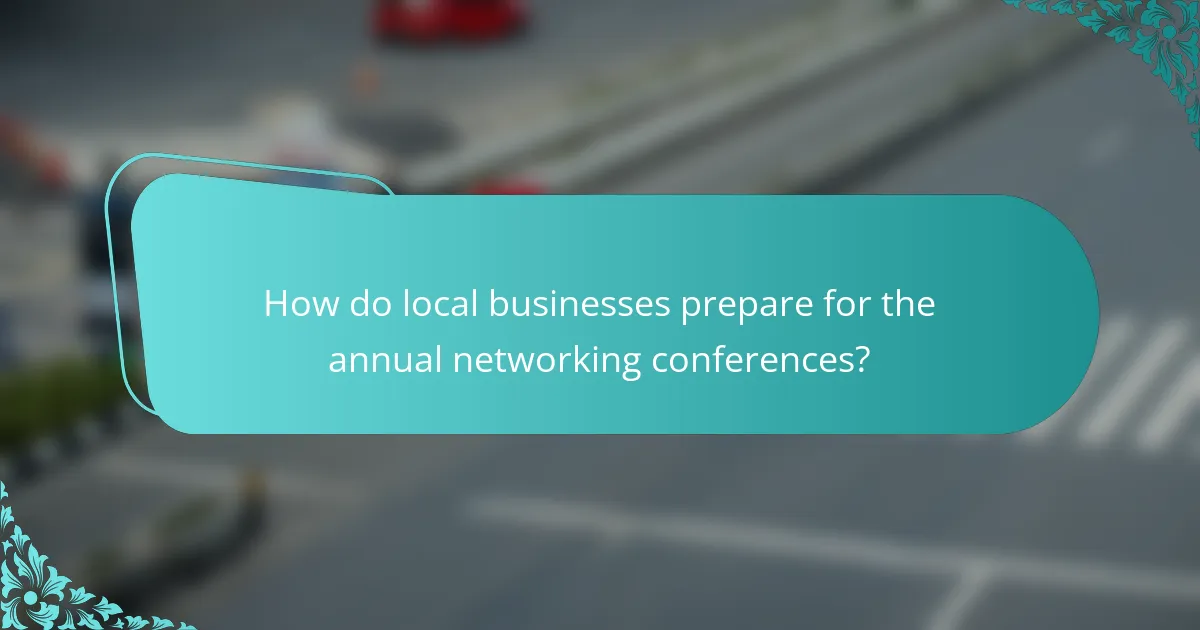The Vermont Chamber of Commerce is a key business organization dedicated to supporting and advocating for the interests of Vermont businesses since its establishment in 1918. This article examines the role of the Chamber in enhancing the state’s economic environment through resources, networking opportunities, and educational programs. It highlights the preparation strategies local businesses employ for annual networking conferences, including goal setting and marketing updates, as well as the importance of post-event follow-ups for relationship building. Additionally, the article explores future trends in networking conferences, such as increased digital engagement, hybrid event formats, and a focus on sustainability and industry-specific topics, reflecting the evolving needs of local businesses in Vermont.

What is the Vermont Chamber of Commerce?
The Vermont Chamber of Commerce is a business organization that supports and advocates for the interests of Vermont businesses. It aims to enhance the state’s economic environment. The Chamber provides resources, networking opportunities, and educational programs for its members. Established in 1918, it has a long history of promoting business growth in Vermont. The organization plays a crucial role in influencing policy decisions that affect the business community. It also hosts events and conferences to connect business leaders. These activities foster collaboration among local businesses. Overall, the Vermont Chamber of Commerce is essential for supporting economic development in the region.
How does the Vermont Chamber of Commerce support local businesses?
The Vermont Chamber of Commerce supports local businesses through various initiatives. It offers networking opportunities that connect business owners with potential partners and clients. These networking events foster collaboration and knowledge sharing among members. Additionally, the Chamber provides resources such as training programs and workshops. These programs help businesses improve their operations and marketing strategies. The Chamber also advocates for local businesses at the state level. It works to influence policies that benefit the business community. Furthermore, the Vermont Chamber of Commerce promotes local businesses through marketing campaigns. These efforts increase visibility and attract customers to member businesses.
What services and resources does the Vermont Chamber of Commerce provide?
The Vermont Chamber of Commerce provides various services and resources to support local businesses. These include advocacy for business-friendly policies at the state level. They offer networking opportunities through events and conferences. The Chamber also provides educational resources and training programs. Members can access market research and economic data. They facilitate connections between businesses and potential partners. Additionally, the Chamber promotes tourism and economic development initiatives. These services aim to enhance the business environment in Vermont.
How does membership in the Vermont Chamber of Commerce benefit businesses?
Membership in the Vermont Chamber of Commerce provides businesses with networking opportunities and resources. Members gain access to events that facilitate connections with other local businesses. These events often include annual conferences and workshops tailored to various industries. Networking can lead to partnerships, collaborations, and client referrals.
Additionally, members receive advocacy support for business interests at the state level. The Chamber actively represents the concerns of its members in legislative matters. Members also benefit from educational resources, including webinars and training sessions. These resources help businesses stay informed about industry trends and best practices.
Research indicates that businesses involved in chambers of commerce experience increased visibility and credibility within their communities. According to a study by the Schapiro Group, 63% of consumers are more likely to buy goods and services from chamber members. This statistic underscores the tangible benefits of membership in the Vermont Chamber of Commerce.
What are the annual networking conferences organized by the Vermont Chamber of Commerce?
The Vermont Chamber of Commerce organizes several annual networking conferences. These include the “Vermont Business and Industry EXPO,” which focuses on connecting businesses with resources. Another event is the “Vermont Economic Conference,” which addresses economic trends and opportunities. The “Vermont Chamber Annual Meeting” is also significant, featuring keynotes and networking opportunities. Each conference aims to foster connections among local businesses and enhance economic growth.
What is the purpose of these annual networking conferences?
The purpose of these annual networking conferences is to facilitate connections among local businesses. These events provide opportunities for entrepreneurs to meet potential clients and partners. They foster collaboration and idea-sharing within the business community. Networking conferences often feature workshops and speakers that offer valuable insights. The Vermont Chamber of Commerce organizes these conferences to support economic growth. Statistics show that businesses that network effectively can increase their revenue by up to 20%. Overall, these conferences are essential for building relationships and enhancing business opportunities.
How are the annual networking conferences structured?
Annual networking conferences are structured around key components such as sessions, workshops, and networking opportunities. Each conference typically includes keynote speakers who present on relevant industry topics. Breakout sessions allow for smaller group discussions and deeper engagement. Workshops often provide hands-on experience and practical skills. Networking events are scheduled to facilitate connections among attendees. Registration and check-in processes are organized to streamline participant entry. The overall schedule is designed to maximize attendee interaction and learning. These structures aim to enhance the value for local businesses participating in the conferences.
What impact do the annual networking conferences have on local businesses?
Annual networking conferences significantly benefit local businesses. They provide opportunities for connections with potential clients and partners. Such events often lead to increased visibility for participating businesses. Local businesses can showcase their products and services to a wider audience. Networking fosters collaboration and knowledge sharing among industry peers. According to a study by the Vermont Chamber of Commerce, 70% of attendees reported gaining valuable contacts. Additionally, 60% of businesses experienced increased sales within six months post-conference. These statistics highlight the tangible impact of networking conferences on local business growth.
How do networking opportunities at the conferences lead to business growth?
Networking opportunities at conferences lead to business growth by facilitating connections between entrepreneurs and potential clients. These interactions can result in partnerships, collaborations, and new customer acquisitions. Attendees often share resources and knowledge that can enhance business strategies. Networking also increases visibility within the industry, attracting attention to products and services. According to a study by the Harvard Business Review, 70% of jobs are found through networking. This statistic highlights the importance of relationships in driving business success. Additionally, regular engagement at conferences can foster long-term relationships that yield ongoing benefits.
What success stories have emerged from past conferences?
Past conferences organized by the Vermont Chamber of Commerce have led to numerous success stories for local businesses. One notable example is the partnership between a small tech startup and a larger company formed during a networking session. This collaboration resulted in a significant increase in the startup’s revenue, boosting it by 150% within a year.
Another success story involves a local artisan who gained exposure through a conference showcase. This exposure led to a contract with a major retailer, expanding the artisan’s market reach significantly. Additionally, several businesses reported enhanced visibility and new client acquisitions directly stemming from connections made at these conferences.
These outcomes illustrate the tangible benefits that networking opportunities can provide for local enterprises.

How do local businesses prepare for the annual networking conferences?
Local businesses prepare for annual networking conferences by setting clear goals for participation. They identify key contacts to connect with during the event. Businesses also update marketing materials, such as brochures and business cards. They often create engaging presentations to showcase their offerings. Additionally, local businesses may practice their networking pitches. They research attending companies and their representatives beforehand. Many also schedule meetings in advance to maximize opportunities. Finally, businesses often follow up with contacts after the conference to build relationships.
What strategies can businesses employ to maximize their networking experience?
Businesses can maximize their networking experience by setting clear objectives for each event. This allows them to focus on specific goals such as finding new clients or partnerships. Actively engaging with attendees through meaningful conversations is crucial. This fosters connections that can lead to future collaborations.
Utilizing social media before and after the events helps to increase visibility. Promoting participation can attract more relevant contacts. Preparing an elevator pitch ensures effective communication of the business’s value proposition. This concise introduction can leave a lasting impression.
Following up with new contacts after the event is essential. Timely communication reinforces the connection made during the networking event. Attending multiple events throughout the year diversifies networking opportunities. This increases the chances of meeting a wider range of potential partners.
Lastly, participating in workshops or panels can enhance credibility. Sharing expertise positions the business as a thought leader in its industry. These strategies collectively enhance the overall networking experience for businesses.
How can businesses effectively promote themselves during the conferences?
Businesses can effectively promote themselves during conferences by utilizing targeted strategies. They should create eye-catching marketing materials, such as brochures and business cards. Engaging in networking activities is crucial for building connections. Presenting at workshops or panels allows businesses to showcase their expertise. Utilizing social media to share live updates can increase visibility. Offering promotional items can attract attendees to their booths. Collecting contact information through contests or sign-ups helps in follow-up communications. Studies show that businesses that actively engage during conferences see a 30% increase in leads.
What materials should businesses bring to the conferences?
Businesses should bring marketing materials, business cards, and promotional items to conferences. Marketing materials include brochures and flyers that showcase products or services. Business cards facilitate networking and provide contact information. Promotional items, such as branded pens or tote bags, create a lasting impression. Additionally, companies may benefit from bringing a presentation or display setup to engage attendees. Having these materials enhances visibility and fosters connections. These items are essential for effective networking and brand representation at conferences.
What challenges do businesses face when attending these conferences?
Businesses face several challenges when attending conferences. High costs associated with registration, travel, and accommodation can strain budgets. Time away from daily operations may disrupt workflow and productivity. Networking can be overwhelming, leading to missed opportunities. Competition for attention among attendees can hinder relationship building. Additionally, unclear objectives may result in ineffective participation. Limited follow-up after the event can diminish potential benefits. These challenges can ultimately impact the return on investment for attending such conferences.
How can businesses overcome common networking obstacles?
Businesses can overcome common networking obstacles by actively participating in local events and conferences. Engaging in these events fosters connections with industry peers and potential clients. Networking skills can be enhanced through practice and preparation. Research indicates that 70% of professionals benefit from face-to-face interactions at networking events. Utilizing social media platforms can also expand reach and facilitate connections before and after events. Setting specific networking goals helps businesses stay focused and measure success. Following up with new contacts strengthens relationships and opens doors for future opportunities.
What are some tips for first-time attendees of the conferences?
Arrive early to familiarize yourself with the venue and schedule. This allows you to plan your day effectively. Bring plenty of business cards to share with other attendees. Networking is a key component of conferences. Attend workshops and sessions that align with your interests and goals. This maximizes your learning experience. Engage in conversations during breaks to expand your network. Follow up with new contacts after the event. This reinforces connections made during the conference. Be open to new ideas and perspectives. This can lead to valuable insights and collaborations.

What future trends can be expected from the Vermont Chamber of Commerce’s networking conferences?
Future trends for the Vermont Chamber of Commerce’s networking conferences will likely include increased digital engagement. As businesses adapt to a more virtual landscape, hybrid events will become more common. These formats will allow for broader participation, reaching those unable to attend in person. Enhanced networking opportunities through digital platforms will facilitate connections among attendees. Additionally, a focus on sustainability will be evident, with conferences incorporating eco-friendly practices. The incorporation of diverse topics such as technology and innovation will be prioritized. Data from past conferences indicates a growing interest in industry-specific sessions. Overall, these trends reflect the evolving needs of local businesses in Vermont.
How might the format of the conferences evolve to meet changing business needs?
The format of conferences may evolve by incorporating hybrid models that blend in-person and virtual participation. This change allows businesses to reach a broader audience while accommodating diverse preferences. Increased use of technology can facilitate interactive sessions, enhancing engagement among attendees. Additionally, conferences may focus on niche topics to address specific industry challenges. Shorter, more focused sessions can cater to busy professionals seeking targeted information. Networking opportunities may shift to structured formats that promote meaningful connections. Data-driven insights will guide the selection of themes and speakers, ensuring relevance to current business needs. These adaptations will reflect the dynamic landscape of business interactions and collaboration.
What role will technology play in future networking conferences?
Technology will play a crucial role in future networking conferences. It will enhance connectivity among participants through virtual platforms. These platforms will allow remote attendees to engage in real-time discussions. Additionally, technology will facilitate data sharing and collaboration via cloud-based tools. Event apps will provide schedules, speaker information, and networking opportunities. Virtual reality could offer immersive experiences for attendees. Analytics tools will help organizers measure engagement and improve future events. According to a report by Eventbrite, 67% of event organizers believe technology enhances attendee experience.
What are best practices for local businesses to engage with the Vermont Chamber of Commerce?
Local businesses can engage effectively with the Vermont Chamber of Commerce by participating in events and networking opportunities. Attending annual conferences fosters connections with other members and potential clients. Regularly updating their business information on the Chamber’s website enhances visibility. Joining committees or working groups allows businesses to influence local initiatives. Utilizing Chamber resources, such as workshops and seminars, can improve business practices. Collaborating on community projects showcases commitment to local development. Lastly, maintaining communication with Chamber staff can provide valuable insights and support. These practices help local businesses maximize their membership benefits and strengthen community ties.
How can businesses leverage their membership for long-term benefits?
Businesses can leverage their membership for long-term benefits by actively participating in networking opportunities and utilizing resources provided by the Vermont Chamber of Commerce. Engaging in annual conferences fosters connections with other local businesses. These relationships can lead to collaborations, partnerships, and referrals. Accessing educational resources helps businesses stay informed about industry trends. This knowledge can enhance their competitive edge. Additionally, members can benefit from marketing opportunities through chamber platforms. This exposure increases visibility within the community. Overall, leveraging membership enhances growth potential and sustainability for local businesses.
What ongoing support does the Vermont Chamber of Commerce offer beyond the conferences?
The Vermont Chamber of Commerce offers various ongoing support services beyond conferences. These services include advocacy for business interests at the state level. They provide resources such as business development tools and networking opportunities. The Chamber also offers educational programs to enhance business skills. Members receive access to exclusive events and workshops throughout the year. Additionally, they provide information on regulatory changes and economic trends. This ongoing support helps businesses adapt and thrive in the local market.
The Vermont Chamber of Commerce is a key business organization dedicated to supporting and advocating for the interests of Vermont businesses since its establishment in 1918. This article explores the various initiatives and resources the Chamber provides, including networking opportunities, educational programs, and advocacy efforts that enhance the local business environment. It highlights the significance of annual networking conferences, detailing their structure, impact on business growth, and strategies for effective participation. Additionally, the article discusses how local businesses can leverage their membership for long-term benefits and the ongoing support offered by the Chamber beyond these conferences.


